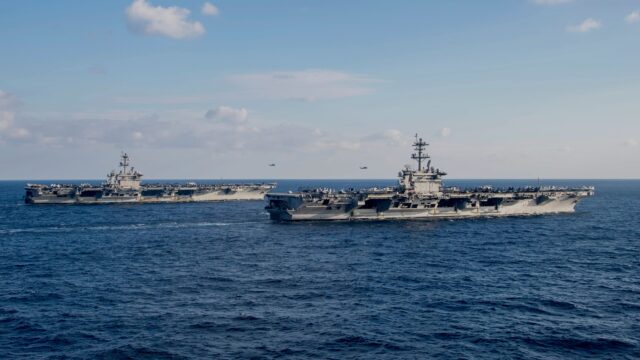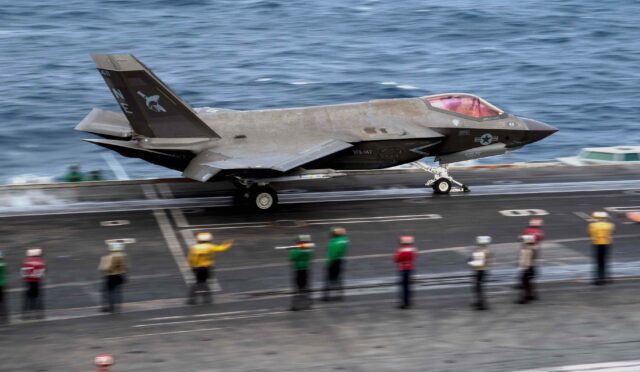F-35C lost in South China Sea
On Monday, the 24th of January, the US Naval Institute News released that there had been a landing mishap on the deck of USS Carl Vinson when a landing F-35C fell off the flight deck.
The USS Carl Vinson is a Nimitz-class super carrier named after a congressman from Georgia who was known as “the Father of the Two-Ocean Navy” (the Vinson-Walsh act), a law enacted in 1940 which increased the size of the US Navy by 70%.

The USS Carl Vinson is taking part in dual-carrier operations, one of two US aircraft carriers, operating in the South China sea with the USS Abraham Lincoln Strike Group. The operation began the day before, in response to multiple incursions of Chinese aircraft in Taiwan’s ADIZ (Air Defence Identification Zone).
This quote from USNI news refers to CSG1, which is the Carl Vinson Carrier Strike Group, based around the aircraft carrier USS Carl Vinson. The Carl Vinson Carrier Strike Group includes over 5,000 crew members and 65 fixed and rotary-wing aircraft.
“Our ability to rapidly aggregate and work collectively alongside CSG 3, highlights the U.S. Navy’s ability to deliver overwhelming maritime force, when called upon, to support a free and open Indo-Pacific region,” Rear Adm. Dan Martin, the commander of CSG1 , said in the Navy news release. “We are committed to ensuring the lawful use of the sea and free flow of commerce while deterring those who challenge the shared vision of a free and open Indo-Pacific now and into the long-term future.”

The F-35C Lightning II, designed and built by Lockheed Martin, is the US Navy’s first stealth fighter.
The U.S. Navy and Marine Corps’ carrier variant has larger wings and more robust landing gear than the other variants, making it suitable for catapult launches and fly-in arrestments aboard naval aircraft carriers. Its wingtips fold to allow for more room on the deck on the carriers while deployed.
The jet’s estimated value is $115 million USD.

The US Navy has confirmed only that the F-35C Lightning II, assigned to Carrier Air Wing 2, crashed on the deck of the carrier while conducting routine flight operations and that additional details and the cause of the in-flight mishap is under investigation. This unverified image is said to be the fighter jet sinking into the sea.
— OedoSoldier (@OedoSoldier) January 27, 2022
The pilot ejected from the aircraft and was rescued by a US military helicopter. Seven sailors on the deck were injured, with three requiring medevac to a medical facility in Manila. Of the three, one was in critical condition but now all are said to be stable. Three of the four sailors treated on the ship have been released with the fourth still undergoing treatment.
Based on the amount of injuries on deck, it is conjectured that an arrestor wire broke and whipped across the deck.
However, this video, which is also unverified but appears to be of the F-35C as it lands, ends with smoke and a loud thud. Assuming that it is real, this would imply a ramp strike, where the aircraft impacts the rear of the carrier below the level of the flight deck.
The only official information is that the damage to the aircraft carrier’s deck was superficial. This is the second F-35 crash this year and the seventh overall.
The US Navy mishap hit international press when the US Navy admitted that they were in a race to recover the F-35 before the Chinese claim salvage rights for the plane. China has submarines and deep diving submersibles in the South China Sea. Further complicating the issue is the Chinese claim to most of the territory of the South China Sea, despite a 2016 international tribunal declaring that there was no legal basis for their claim.
Yesterday, the Chinese Foreign Ministry spokesman made a statement that Beijing was not searching for the sunken F-35C. “We have no interest in their aircraft.”
US national security experts are not convinced.
The former director of operations at the US Pacific Command’s Joint Intelligence Centre told the press that he thinks it is likely that Beijing will claim to be salvaging the jet as a potential environmental hazard.
Just two months ago, a Royal Navy F-35, the F-35B STOVL variant, crashed on take off from the Royal Navy carrier HMS Queen Elizabeth. The pilot safely ejected but the aircraft was lost. The Royal Navy asked for US assistance to recover the wreckage, concerned that Russian submarines operating in the area could learn about the technology.
The US Navy dispatched a specialist deep salvage ship which recovered the aircraft, probably by attaching inflatable bags attached to the jet’s fuselage, which was still in one piece. When those bags are inflated, the wreckage floats to the surface. The following photo began making the rounds last week, supposedly showing the recovered F-35B.
This is the wreckage of a British #F35B fighter salvaged from the #Mediterranean. pic.twitter.com/yH2tubCCJ3
— Military Armed Forces (@Military9Army) January 21, 2022
It should be possible to salvage the US Navy’s F-35C in the same manner. However, this is a time-sensitive operation, as the emergency locator beacon must still be sounding so that the pinger locator can locate the wreckage exactly. There is also a potential issue in that the missing F-35C was armed with missiles.
The big problem is that the closest salvage vessel is at least ten days away from the crash site and one expert predicts it could take up to four months. Former adviser to the US Chairman to the Joint Chiefs Abi Austen told media that that was too late.
It’s vitally important the US gets this back,” she says. “The F-35 is basically like a flying computer. It’s designed to link up other assets – what the Air Force calls ‘linking sensors to shooters’.
It’s all about who’s the biggest dog in the park! This is basically The Hunt For Red October meets The Abyss – it’s a brilliant three-act play.
I suspect the US Navy personnel responsible for recovering the jet would not use the word “brilliant” to describe the situation. One military officer told BBC news that the easiest resolution of the problem would be to torpedo it. “But that’s not thought to be an avenue under consideration,” concludes the article.








If the corpse of an F-35 is so critically important, perhaps the using forces should consider installing a water-activated time fuse, connected to demolition charges. Shouldn’t need much bang, if electronics is the critical component.
I thought some form of floatation device, deployed if the ejection seat was “fired”? Only good if the accident happened near friendly ships though. Otherwise it would make it easy for others to salvage!
Maybe a small explosive as suggested, as was done with some radio equipment in WW2. However all add complications to the aircraft and more chances of accidents on board.
Don’t forget the added weight, which could affect performance.
This really is a unique situation, only a problem because a) the aircraft is so new, b) the aircraft crashed near the one country that could probably meaningly reverse engineer it and c) the impact left the airframe intact enough that China can get useful from it. So it’s not worth the risk of a self-destruct device, especially for something that’ll see widespread service.
I know the USN has been downplaying this option, but most CVBGs usually have a friendly submarine close at hand, so they’ll know if a Chinese sub tries to sneak in. If they think the Chinese will get there first, they’ll just blow it up. It’s not like it’s going to fly again, and if it was a ramp strike or arrestor wire break, they don’t really need the aircraft for the post-crash analysis.
I’m curious if you have heard of the Trevor Jacobs plane incident. I was wondering if you we’re going to write an article on it.
Good question. I’ve been thinking about it but I’m not sure I have a lot to add. Maybe. :)
An interesting angle on this might be “I crashed my plane, now what?”, i.e. a rundown of what a private pilot would need to do (assuming she’s ok and knows where her aircraft is), both from a legal and a practical perspective; and what other organisations get active. I got the idea from a reddit thread titled “Trevor Jacob rented a helicopter to move the wreck?”, where commenters pointed out that he’d have to report the crash immediately, and that the NTSB has dibs on the wreck; I didn’t know that. (Their case number is WPR22LA049, but the docket is not public right now?) I’ve also wondered about what the owner had to do about to the Seawind 3000 that ended up at the bottom of a lake a few blog posts ago.
Another blog-compatible angle might be “pilots with parachutes”; we’ve had this come up on the blog before in the context of military or test pilots, but apparently in aerobatic and competitive sailplane flying, parachutes are also common; but unusual in other situations, contrary perhaps to public expectation. I think that would also tie in well with the blog title! ;-)
The Navy has retrieved the plane by sending down a ROV to attach lines: https://www.nytimes.com/2022/03/03/us/navy-jet-recovered.html
Oooh, thank you!